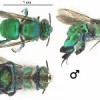Abstract
Green orchid bees are a quite conspicuous and charismatic species. This is mostly due to their large size and bright metallic-green coloration. They are very fast and agile flyers, and can be seen quickly darting from flower to flower separated by long periods of hovering. Male orchid bees collect fragrant volatile compounds from their environment and present them to females by fanning their wings and “spray ventilating” their bouquet for the inspection of prospective mates. In Florida, male green orchid bees are attracted to chemicals produced by certain wood-rot fungi, decomposing vegetation, perfume flowers, and certain essential oils such as clove and cinnamon oil. Male green orchid bees can be quickly and easily attracted and observed by soaking a small piece of paper with clove oil and placing it outside. This 4-page fact sheet was written by Aaron Mullins, and published by the UF Department of Entomology and Nematology, October 2013.
http://edis.ifas.ufl.edu/in1013
References
Aquino-Vázquez A, Cuadriello-Aguilar JI. 1990. Un nido de Euglossa viridissima Friese 1899 (Hymenoptera: Apidae: Euglossini), pp. 117-118B In XXV Congreso Nacional de Entomologíá. Programa y resumenes. Oaxaca, Oaxaca, Mexico.
Bembé B. 2004. Functional morphology in male euglossine bees and their ability to spray fragrances (Hymenoptera, Apidae, Euglossini). Apidologie 35: 283-291. https://doi.org/10.1051/apido:2004013
Carvalho Filho FS. 2010. Scent-robbing and fighting among male orchid bees, Eulalema (Apeulalema) nigrata Lepeletier, 1841 (Hymenoptera: Apidae: Euglossini). Biota Neotropica 10: 405-408. https://doi.org/10.1590/S1676-06032010000200038
Dressler RL. 1967. Pollination by euglossine bees. Evolution 22: 202-210. https://doi.org/10.1111/j.1558-5646.1968.tb03463.x
Eltz T, Fritzsch F, Petch JR, Zimmermann Y, Ramirez SR, Quezada-Euan JG, Bembe B. 2011. Characterization of the orchid bee Euglossa viridissima (Apidae: Euglossini) and a novel cryptic sibling species by morphological, chemical, and genetic characters. Zoological Journal of the Linnean Society 163: 1064-1076. https://doi.org/10.1111/j.1096-3642.2011.00740.x
Hinojosa-Díaz IA, Feria-Arroyo TP, Engel MS. 2009. Potential distribution of orchid bees outside their native range: The cases of Eulaema polychroma (Mocsáry) and Euglossa viridissima Friese in the USA (Hymenoptera: Apidae). Diversity and Distributions 15: 421-428. https://doi.org/10.1111/j.1472-4642.2008.00549.x
Liu H, Pemberton RW. 2009. Solitary invasive orchid bee outperforms co-occurring native bees to promote fruit set of an invasive Solanum. Oecologia 159: 515-525. https://doi.org/10.1007/s00442-008-1232-6
Pemberton RW, Wheeler GS. 2006. Orchid bees don't need orchids: evidence from the naturalization of an orchid bee in Florida. Ecology 87: 1995-2001. https://doi.org/10.1890/0012-9658(2006)87[1995:OBDNOE]2.0.CO;2
Skov C, Wiley J. 2005. Establishment of the Neotropical orchid bee Euglossa viridissima (Hymenoptera: Apidae) in Florida. Florida Entomologist 88: 225-227. https://doi.org/10.1653/0015-4040(2005)088[0225:EOTNOB]2.0.CO;2
Wiley J. 2004. Entomology Section. Insect Detection. Euglossa sp., orchid bee. Triology 43 (3).
Unless otherwise specified, articles published in the EDIS journal after January 1, 2024 are licensed under a Creative Commons Attribution-NonCommercial-NoDerivs 4.0 International (CC BY-NC-ND 4.0) license.

